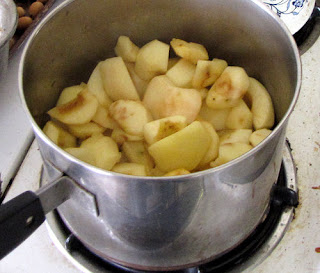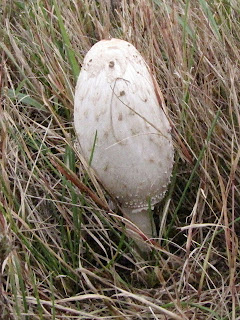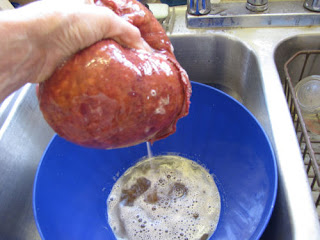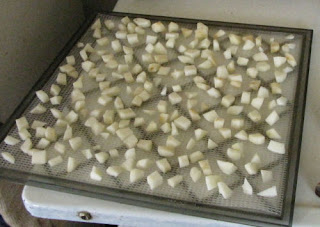 shaggy mane mushrooms, just harvested (photo by jhy) shaggy mane mushrooms, just harvested (photo by jhy) |
I have read, and been told by several people that shaggy mane mushrooms,
Coprinus comatus, are some of the best there is, but I had never tried them. They pop up in my own lawn once every few years, so I decided to give them a try. See
Identifying Shaggy Mane Mushrooms for tips on harvesting them.
The trick is to get them before they self-digest. In the first picture you can see that two of the ones I picked are beginning to turn black at the lower edges. I simply cut that part off. Supposedly it won't hurt you, but will affect the flavor. I was happy enough to cut it off. You can also see the characteristic hollow stem.
 shaggy mane mushrooms, halved (photo by jhy) shaggy mane mushrooms, halved (photo by jhy) |
Next, I cut them in half. Here's what they looked like.
 shaggy mane mushrooms, scraped (photo by jhy) shaggy mane mushrooms, scraped (photo by jhy) |
Since I didn't really have any further instructions on what to do, I decided to scrape off the shaggy outer layer. This was easy to do, I rubbed it with the back of my knife and it peeled right off. I don't know if you really need to do this or not, but it was an easy way to remove the superficial dirt. The mushroom was fairly fragile, but not crumbly. I then cut it in small pieces and fried it in a little butter.
 shaggy mane mushrooms, fried (photo by jhy) shaggy mane mushrooms, fried (photo by jhy) |
The pieces cooked quickly but didn't really brown because they exuded this milky white juice. I wondered if I did something wrong. I had collected them on a very cold morning, and wondered if I should have let them come to room temperature before cooking. But some later research revealed that this is just what these mushrooms do. They are recommended for mushroom soup, and I can see why. If I have a chance to collect some more, I will probably try that.
 shaggy mane mushrooms, fried with an egg (photo by jhy) shaggy mane mushrooms, fried with an egg (photo by jhy) |
As it was, I simply cooked them with an egg for my breakfast. The flavor is mild and sweet, and the texture is silky. I can see why they have such a good reputation. I will definitely make it a point to collect these when I see them in the future.
They need to be cooked right after collecting. They will continue to self-digest even after picking. Cooked ones can supposedly be frozen. I simply put the extras in the refrigerator and had them for breakfast the next day.
With any wild food, it is a good idea to only eat a small amount the first time you try it, to be certain that you don't have some personal allergy, even if the food is considered to be edible. I had no adverse reaction to these mushrooms, and since they are quite easy to identify, I'll be watching for them.

 slices of apple bread (photo by jhy)
slices of apple bread (photo by jhy)  spread the dough in a loaf pan and level (photo by jhy)
spread the dough in a loaf pan and level (photo by jhy) 




























